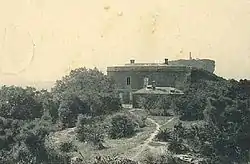Shoushan (Kaohsiung)
Shoushan (Chinese: 壽山, also commonly known in English as Monkey Mountain) is a mountain in Gushan District, Kaohsiung, Taiwan, north of the main entrance to Kaohsiung Harbor. It was named Ape Hill by the Dutch in the 17th century to describe many monkeys on this mountain. It is also called Chaishan (柴山) and includes the Snake Hill (蛇山 - a 17th-century term) in its northern part, and Long Life Hill (壽山) – named by Japanese in 1911-1915 for the crown-prince Hirohito – in the southern part. In some old maps, the peak of the hill is called Saracen's Head. Now it is a nature park where biological diversity can be seen.
| Shoushan | |
|---|---|
 Shoushan as seen from the National Sun Yat San University | |
| Highest point | |
| Elevation | 356 meters |
| Coordinates | 22°38′19″N 120°15′54″E |
| Geography | |
| Location | Kaohsiung, Taiwan |
| Parent range | Tzaishan |
| Geology | |
| Age of rock | More than 1000 ka |
| Climbing | |
| Easiest route | hiking |
History
Shousan is one of the oldest ruins of civilization founded in Kaohsiung, dating back 4000 to 5000 years ago.[1] Military installations were constructed through both Qing rule throughout the 17 and 18th century and Japanese rule from 1895 to 1945. It is now part of the Shoushan National Nature Park, and serves as a tourism attraction.[2]
Historical landmarks
- Former British Consulate at Takao was established in 1865 as a trade centre between the Chinese and the English. It now serves as a preserve historical landmark.[3]

- Sizihwan – Located at the southern base of the mountain and facing the Pacific Ocean, Sizihwan is a natural harbor that serves as a main tourist attraction in Kaohsiung due to its oceanic scenery.
- National Sun Yat San University – First established in 1924 by Sun Yat-Sen as a means to create an education institution based on democratic ideals, the university was re-established in Sizihwan in 1980 after the KMT relocated in Taiwan.
Ecology
Plant life
Despite its status as a secondary forest, there are over 800 species of plants residing within Shoushan, with its tropical climate providing a suitable place for growth and species diversity.[4] Notable species include:
- Dendrocnide meyeniana ("dog bitten fruit" in Chinese) - notable for the rashes it can cause on human skin.
- Paper mulberry
- Banyan
Animal species
Shoushan hosts a total of 5 amphibian species, 24 reptiles, 106 birds and 8 mammals.[5] Notable species include:
- Formosan rock macaque, a rare animal found only in Taiwan.

- Masked palm civet
- Black-throated laughingthrush
- Troides aeacus, a swallowtail butterfly found only in Taiwan and China
Geography
Shoushan is located in southern Taiwan within the vicinity of Kaohsiung stretching across the Gushan district. 5.5 Kilometres long from North to South and 2.5 kilometers wide from East to West with and overall landmass of around 1200 acres. In terms of height, Shoushan reaches a maximum elevation at around 365 meters from above sea level. Stretching from the Zhuoying northern district to the southern peak of Sizihwan, Shoushan is the largest and most prominent landmark in Kaohsiung.[6]
Climate
The climate of Shoushan belongs in the tropical standard, with an average annual temperature of 25.1 Celsius degrees and the lowest at 19.1 degrees in January and the highest at 29.1 in August. The annual rainfall totals up to 1748.6 millimetres, with the major wet season taking place between June and August.
Geology
The mountain is made up of coral reefs and calcium carbonate, with evidence of the landscape rising above sea level. The Calcium Carbonate is generally consisted of coral, sea algae and shells, further supporting the theory. Due to its rise from sea level, the landscape of the mountain is severely effected by erosion from the sea, resulting in jagged cliffs and even calcium carbonate formed caves with stalactite.[7]
Caves
The mountain and foothills contain a large number of caves, many of which are accessible. Four caves are open to the public during the dry season (November 1 to April 30) however a permit from the Shoushan National Nature Park management office is required for access.[8]
Notability
Shoushan is the one of the mountains where Kaohsiung residents can see natural biological specimens within an hour's drive. There is an extensive system of boardwalk hiking trails that circle the mountain. Hikers can enjoy tea at various tea stations sprinkled throughout the trails. Water is carried to the tea stations by hikers who bring it from a reverse osmosis station at the bottom. From the tea station at the top of the mountain, hikers can see views of the Taiwan Strait through the trees.
The mountain is a reserve for Formosan rock macaques. Thousands of these monkeys reside on the mountain pestering hikers who have food with them.
Transportation
There is an entrance to the mountain just east of the Shou Shan Zoo, as well as one beside the College of Liberal Arts building in National Sun Yat-sen University.
There are three other access points to the mountain along Gushan Road. The southernmost is beside Yuan Heng Temple; a second is located behind the Kaohsiung Municipal Ku Shan Senior High School; and the northernmost is located beside the Long Quan Temple, near the intersection with Xinjiang Road.
References
- "History of Shoushan".
- "About Us". Shoushan National Nature Park.
- "History of the Former British Consulate". Ministry of Culture and History of Kaohsiung.
- "List of Botanic Life in Tczhaishan Mountains (Chinese)". Archived from the original on 2005-01-04.
- Zhang, Xue-Wen (2003). "The Animal Species of Shoushan". The Kaohsiung Ministry of Environment.
- "Moulin National Scenic Area". Taiwan Ministry of Culture.
- Deng, Guang-Muo. The Natural Beauty of the Tzaishan Mountains (Chinese).
- Liao, George. "Spelunkers on Taiwan's Shoushan must have permits or face fine of NT$3,000". www.taiwannews.com.tw. Taiwan News. Retrieved 31 December 2020.